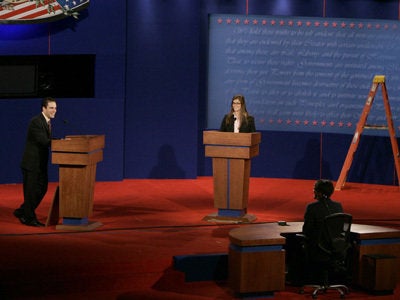
The Jan. 24 Republican debate in Boca Raton got me curious.
As you may recall, moderator Tim Russert asked Mitt Romney, "Will you do for Social Security what Ronald Reagan did in 1983?" A disembodied whisper of "He raised taxes" was heard, followed immediately by Romney's response: "I'm not going to raise taxes."
Theories abounded that the disembodied voice belonged to a "Cyrano" -- an off-stage helper, using a two-way radio to communicate via an earpiece worn by Romney. Possibly the feed had been picked up and amplified by a mike.
While Romney's camp declined comment, television execs dismissed as preposterous the notion that any candidate could employ a Cyrano with the world watching.
But I wondered, in a world where unmanned drones can read a license plate and send a Hellfire missile at the truck, could a candidate get away with it...
Recently I've been immersed in researching techno-gadgetry for my soon-to-be-published-by-Doubleday spy novel. The other day, I read a new book co-authored by the former director of the CIA's Office of Technical Services, Robert Wallace. It turns out that sufficient Cyrano technology not only exists, but has existed since the early 1970s. The CIA created a system known as the SRR-100 for its case officers in Moscow. The case officers wore a wireless earpiece no larger than the head of a Q-Tip that was covered by a silicone cast of the officer's ear. The fake ear was placed over the actual ear.
I began to wonder how far the technology has come since. As it happens, variations of the SRR-100 gadgetry are available to the public for less than $100. High school students make use of these devices to help one another on tests.
One round of Googling led to multiple suppliers. I called CustomEarPiece.com, whose sales manager, Steve Perodi, told me, "The technology absolutely exists for someone using a two-way radio to give instructions to someone onstage via an easily concealable earpiece, over nearly four thousand channels." The earpiece is especially easy to conceal if the wearer has a lot of hair, he added.
Next I wanted to know if a debater could get away with using that technology? A friend of mine who reports for Reuters was interested in the issue, and encouraged me to do some digging (the full results will likely be published by Reuters shortly).
A few calls later, I'd learned that the Commission on Presidential Debates employs an individual as Frequency Coordinator. He's armed with a spectrum analyzer, a device capable of detecting communication by means of electrical, acoustic or optical waveform during the debate. Of the prospects of a Cyrano, veteran ABC Frequency Coordinator Steve Mendelsohn told me, "It's improbable but not impossible. My job is to find them, which isn't hard with a spectrum analyzer."
The thing is, I learned, the spectrum analyzer, the best defense, does NOT detect non-radio frequency (RF) communication, like infrared.
"With an infrared transmitter, you can take sound and convert it to something else, like infrared light, and it wouldn't be detected by the spectrum analyzer," said Kevin Murray, who was once National Director of Electronic Countermeasures & New Jersey Director of Investigations at Pinkerton's Inc, and since 1978, has run Murray Associates, a counterespionage firm. "Spectrum analyzers are basically for radio waves."
Infrared signals can be transmitted wirelessly and converted to sound by the earpiece in a fashion the spectrum analyzer cannot detect.
Gary Grossman, Worldwide Senior PR Manager at Tektronix, a leading manufacturer of spectrum analyzers, confirmed in an e-mail that his company's device "is not intended to find infrared. It's designed to find RF."
According to Murray, infrared systems "operate in the near infrared range. A regular solid-state TV camera can pick it up; you'd see a bright glowing light. A custom-made device could work around that though."
So, what if a debater used a custom-made-device the camera couldn't catch?
"A photo-transistor attached to an amplifier sensitive to that range could capture infrared light coming through the air," Murray said. "There's a relatively inexpensive device, the CPM-700 made by REI of Algood, Tennessee, that would work. It's a matter of holding up a wand, and if there are any infrared transmissions, the CPM-700 would receive them and you would be able to listen in, just like the candidate."
Another company, Holosonics, of Watertown, MA, manufactures an "Audio Spotlight" with which a Cyrano's cues could be transmitted via a narrow, targeted ultrasonic stream that only the recipient hears. It requires a candidate to wear no special device--not even a receiver in the ear. The catch is the Cyrano needs the candidate in his line of sight. But line of sight can be augmented in a number of ways. A solid surface can act as a mirror, for example.
The inventor of the Audio Spotlight, Joseph Pompei, told me, "It's extremely unlike the spectrum analyzer would detect it." Asked how he might find his own invention in a debate hall, he said, "You could sweep with an ultrasonic microphone, but that would only detect the ultrasound when it was on. It would be exceedingly difficult."
Similar technology is being used in the war on terror to transmit messages to individual terrorists, so it seems they are hearing from Allah himself -- hence it's nickname: "The Voice of God."
I called three top officials at the Commission on Presidential Debates to ask if any countermeasures were in place.
So far, no answer.
